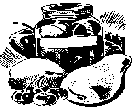Canning & PreservingCanning is an important, safe method for preserving food if practiced properly. The canning process involves placing foods in jars or similar containers and heating them to a temperature that destroys micro-organisms that cause food to spoil. During this heating process air is driven out of the jar and as it cools a vacuum seal is formed. This vacuum seal prevents air from getting back into the product bringing with it contaminating micro-organisms. Safe Canning Methods There are two safe ways of processing food, the boiling water bath method and the pressure canner method:
Whole Tomatoes | Crushed | Without Liquid | With Zucchini | Stewed Seasoned | Mexican Chile Pepper Sauce | Chile Salsa | Chili Sauce Spaghetti Sauce | Peaches | Apricots | Berries | Cherries | Grapefruit Pears | Plumbs | Blackberries | Raspberries | Elderberries Gooseberries | Huckleberries Water Bath Canners A water bath canner is a large cooking pot, with a tight fitting lid and a wire or wooden rack that keeps jars from touching each other. The rack allows the boiling water to flow around and underneath jars for a more even processing of the contents. The rack also keeps jars from bumping each other and cracking or breaking. If a rack is not available, clean cotton dish towels or similar can be used to pack around jars. If a standard canner is not available any large metal container may be used as long as it is deep enough for l to 2 inches of briskly boiling water to cover the jars. The diameter of the canner should be no more than 4 inches wider than the diameter of your stove's burner to ensure proper heating of all jars. Using a wash kettle that fits over two burners is not recommended because the middle jars do not get enough heat. For an electric range, the canner must have a flat bottom. Outdoor fire pits with a solid grate will also work however close attention is required to insure proper boiling temperature.  Pressure Canners
Pressure CannersA pressure canner is a specially-made heavy pot with a lid that can be closed steam-tight. The lid is fitted with a vent (or pet-cock), a dial or weighted pressure gauge and a safety fuse. Newer models have an extra cover-lock as an added precaution. It may or may not have a gasket. The pressure pot also has a rack. Because each type is different, be sure to read the directions for operating. Whole Tomatoes | Crushed | Without Liquid | With Zucchini | Stewed Seasoned | Mexican Chile Pepper Sauce | Chile Salsa | Chili Sauce Spaghetti Sauce | Peaches | Apricots | Berries | Cherries | Grapefruit Pears | Plumbs | Blackberries | Raspberries | Elderberries Gooseberries | Huckleberries Jars Mason jars and Ball jars specifically designed for home canning are best. Commercial mayonnaise jars, baby food and pickle jars should not be used. The mouths of the jars may not be appropriate for the sealing lids and the jars are not made with heavy glass and they are not heat treated. Jars come in a variety of sizes from half-pint jars to half-gallon jars. Pint and quart Ball jars are the most commonly used sizes and are available in regular and wide-mouth tops. If properly used, jars may be reused indefinitely as long as they are kept in good condition. Atlas jars should not be used for home preserving and canning. Jar Lids Most canning jars sold today use a two piece self-sealing lid which consists of a flat metal disc with a rubber-type sealing compound around one side near the outer edge, and a separate screw-type metal band. The flat lid may only be used once but the screw band can be used over as long as it is cleaned well and does not begin to rust. Canning Utensils
Home Recipes When looking for advice and information on preserving food, try to avoid old pamphlets, outdated cookbooks, untrained celebrities and undocumented food shows on TV. Your best source for current information on research and processing instructions are publications made by the U.S. Food and Agriculture Department, College Cooperative Extension Services and major food processing equipment manufactures. please visit our Canning Equipment eStore |
|||
|
|||
|
Visit our Italian Food Recipes web site. Canning Index | email | FAQ's | Glossary Cooking Terms |Recipe Software | Canning Store Canning Cookbooks | Preserving Fruit | Canning Tomatoes © Copyright Canning-Food-Recipes.com / canning basics for preserving food 1997-2008 |
|||
 |
||
|
||